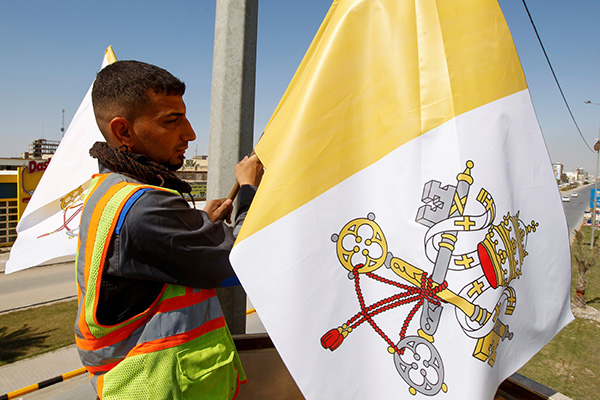
By Inés San Martín
ROME (Crux) — Pope Francis traveled to Iraq on a first-ever pontiff visit to the birthplace of the biblical figure of Abraham. The Pope’s mission during the three day visit is three-fold: encouraging the Christian community, long- time victim of persecution and extremism; pursuing dialogue with Shia Islam; and encountering the Iraqi nation as a whole.
In the meantime, the March 5-8 trip is producing many headaches for those in charge of the pope’s safe- ty. There’s the threat posed by terrorist groups and the ongoing COVID-19 pandemic — a papal representative in the country even tested positive on Saturday, Feb. 27.
However, a series of measures are being taken to guarantee the safety of not only the pope but also those he will encounter.
The crowds have been heavily downsized to avoid the risk of papal events becoming “super spreaders” for the coronavirus and at no point will Pope Francis use the popemobile — he might use an armored car as an exception — when moving around Iraq, to prevent people from gathering out in the streets to greet him as he passes by.
From Friday to Sunday, the pope is scheduled to visit six cities: Baghdad, Najaf, Ur, Mosul, Qaraqosh, and Erbil. One event expected to attract a large crowd is Sunday’s Mass at an open-air stadium in Erbil, the capital of the northern Kurdistan region. The stadium has a capacity for 30,000 spectators, but only 10,000 faithful will be allowed in.
After arriving in Baghdad on Friday, Pope Francis is supposed to leave the Iraqi capital on Saturday to head to Najaf, the third holiest city of Shia Islam after Mecca and Medina. Here, he will be welcomed by Grand Ayatollah Ali al-Sistani, the top cleric in Shia Islam. The meet- ing will be private — in the religious leader’s own home — so it is expect- ed to be free of the protocol-man- dated pomp and circumstance that prevents any real dialogue. Hayder al-Khoei, Director of Foreign Relations of the Al-Khoei Institute in Najaf, said “both the pope and Sistani are advocates of interfaith dialogue [and] unity, and they both condemn violence that uses religion as a cover.”
“The meeting is important because this is not only the first papal visit to Iraq, but it will be the first time in his- tory the head of the Catholic Church is meeting with the head of the Shia Islamic establishment,” said the grandson of Najaf’s late Ayatollah Sayyid Abu al-Qasim al-Musawi al-Khoei, who was the most prominent ayatollah from 1971 until his death in 1992.
On his first day, Pope Francis is scheduled to deliver two speeches: One to the political leadership, where he is expected to issue words in support of pluralism, peace, and religious freedom; and one to the Catholic priests and religious of Iraq, in the Syriac-Catholic Cathedral of Our Lady of Salvation.
On Oct. 31, 2010, five terrorists from Iraq, Syria, and Egypt killed two priests and 45 lay faithful, one of whom was pregnant, at the church.
On Saturday, the pope will also go to the Plain of Ur, believed to have been the birthplace of Abraham, a prophet for Jews, Christians, and Muslims.
Founded in the 5th millennium B.C., and once a port city — the Euphrates River now lies several miles to the north — Ur was meant to be the stage of an interreligious summit that St. John Paul II had dreamed of hosting back in late 1999, serving as the first stop of his pilgrimage through the holiest sites of Christianity. The negotiations with the government of Saddam Hussein failed at the last minute.
Among the many firsts of this trip, is that a Roman pontiff will celebrate Mass in the Chaldean rite on Sunday when the pope’s attention will be almost exclusively with the lo- cal Christian community. He will go to Erbil, capital of the autonomous Kurdistan region in northern Iraq, and from there go to Mosul and Qaraqosh, in the Nineveh Plain.
While in Mosul, a city currently in ruins, the pope will lead a moment of prayer for the victims of conflict. This place was a key headquarters for ISIS. It was from the Old City’s al-Nuri Mosque that the terrorist group’s leader, Abu Bakr al-Baghdadi, declared the establishment of the caliph- ate in 2014.
The mosque and its leaning al-Hadba (“hunchback”) minaret, which stood at 147 feet tall, were built in the 12th century and became iconic Mosul landmarks. Both were destroyed, along with more than 40 other historically-valuable buildings, during the occupation or battle to retake the city.
In Qaraqosh — the land of the prophet Jonah, and until the rise of ISIS, home to a bustling Christian community — Pope Francis will meet with Christians in the Church of the Immaculate Conception, which was vandalized and burned by the Islamic State.
Repeatedly asked by reporters about the pope’s decision to move forth with the trip despite the health risks associated with the visit, a papal spokesman said the Vatican is complying with all the measures requested both by the Iraqi government and the local church authorities.
“There is also an urgency in things, all the precautions have been taken from a health point of view, but perhaps the best way to interpret this journey is as an act of love for this land, for its people, and for its Christians,” Bruni said. “Every act of love can be interpreted as extreme, but as an extreme confirmation to be loved and confirmed in that love.”
Inés San Martín is part of the press pool traveling with the Pope on his trip to Iraq.

May God grant protection to our Holy Father.